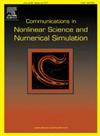不可压缩Navier-Stokes方程线性二阶能量稳定辅助变量法的数值分析
IF 3.8
2区 数学
Q1 MATHEMATICS, APPLIED
Communications in Nonlinear Science and Numerical Simulation
Pub Date : 2024-12-25
DOI:10.1016/j.cnsns.2024.108561
引用次数: 0
摘要
本文研究了基于辅助变量法的不可压缩时相关Navier-Stokes方程二阶线性有限元格式的无条件稳定性和收敛性分析。首先,通过引入一个非局部变量,并为其设计一个额外的常微分方程,建立了具有三变量的Navier-Stokes方程的相应等效系统,该系统对保持无条件能量稳定起关键作用。其次,建立了全离散格式,采用稳定有限元空间逼近空间变量,线性项隐式逼近,非线性项显式逼近;因此,每个时间步只需要求解几个常系数代数系统,说明了较高的实用效率。通过数值实验验证了理论结果。本文章由计算机程序翻译,如有差异,请以英文原文为准。
Numerical analysis of a linear second-order energy-stable auxiliary variable method for the incompressible Navier–Stokes equations
In this paper, the unconditional stability and convergence analysis of a second-order linear finite element scheme based on the auxiliary variable method are studied for the incompressible time-dependent Navier–Stokes equations. Firstly, a corresponding equivalent system of the Navier–Stokes equations with three variables is formulated by introducing a nonlocal variable and designing an additional ordinary differential equation for it which plays the key role to maintain the unconditional energy stability. Secondly, a fully discrete scheme is developed and the stable finite element spaces are adopted to approximate the spatial variables, which is implicit for the linear terms and explicit for the nonlinear term. Hence, one only needs to solve several constant coefficient algebraic systems at each time step illustrating the high practical efficiency. Numerical experiments are presented to verify the theoretical results.
求助全文
通过发布文献求助,成功后即可免费获取论文全文。
去求助
来源期刊

Communications in Nonlinear Science and Numerical Simulation
MATHEMATICS, APPLIED-MATHEMATICS, INTERDISCIPLINARY APPLICATIONS
CiteScore
6.80
自引率
7.70%
发文量
378
审稿时长
78 days
期刊介绍:
The journal publishes original research findings on experimental observation, mathematical modeling, theoretical analysis and numerical simulation, for more accurate description, better prediction or novel application, of nonlinear phenomena in science and engineering. It offers a venue for researchers to make rapid exchange of ideas and techniques in nonlinear science and complexity.
The submission of manuscripts with cross-disciplinary approaches in nonlinear science and complexity is particularly encouraged.
Topics of interest:
Nonlinear differential or delay equations, Lie group analysis and asymptotic methods, Discontinuous systems, Fractals, Fractional calculus and dynamics, Nonlinear effects in quantum mechanics, Nonlinear stochastic processes, Experimental nonlinear science, Time-series and signal analysis, Computational methods and simulations in nonlinear science and engineering, Control of dynamical systems, Synchronization, Lyapunov analysis, High-dimensional chaos and turbulence, Chaos in Hamiltonian systems, Integrable systems and solitons, Collective behavior in many-body systems, Biological physics and networks, Nonlinear mechanical systems, Complex systems and complexity.
No length limitation for contributions is set, but only concisely written manuscripts are published. Brief papers are published on the basis of Rapid Communications. Discussions of previously published papers are welcome.
 求助内容:
求助内容: 应助结果提醒方式:
应助结果提醒方式:


